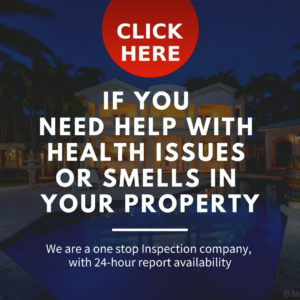Volatile Organic Compounds

AVAILABLE SERVICE IN MIAMI, BROWARD & PALM BEACH COUNTIES
What are volatile organic compounds (VOCs)?
Volatile organic compounds are compounds that have a high vapor pressure and low water solubility. Many VOCs are human-made chemicals that are used and produced in the manufacture of paints, pharmaceuticals, and refrigerants. VOCs typically are industrial solvents, such as trichloroethylene; fuel oxygenates, such as methyl tert-butyl ether (MTBE); or by-products produced by chlorination in water treatment, such as chloroform. VOCs are often components of petroleum fuels, hydraulic fluids, paint thinners, and dry-cleaning agents. VOCs are common ground-water contaminants.
Volatile organic compounds (VOCs) are emitted as gases from certain solids or liquids. VOCs include a variety of chemicals, some of which may have short- and long-term adverse health effects. Concentrations of many VOCs are consistently higher indoors (up to ten times higher) than outdoors. VOCs are emitted by a wide array of products numbering in the thousands. Examples include: paints and lacquers, paint strippers, cleaning supplies, pesticides, building materials and furnishings, office equipment such as copiers and printers, correction fluids and carbonless copy paper, graphics and craft materials including glues and adhesives, permanent markers, and photographic solutions.
Organic chemicals are widely used as ingredients in household products. Paints, varnishes, and wax all contain organic solvents, as do many cleanings, disinfecting, cosmetic, degreasing, and hobby products. Fuels are made up of organic chemicals. All of these products can release organic compounds while you are using them, and, to some degree, when they are stored.
EPA’s Total Exposure Assessment Methodology (TEAM) studies found levels of about a dozen common organic pollutants to be 2 to 5 times higher inside homes than outside, regardless of whether the homes were located in rural or highly industrial areas. Additional TEAM studies indicate that while people are using products containing organic chemicals, they can expose themselves and others to very high pollutant levels, and elevated concentrations can persist in the air long after the activity is completed.
Sources of VOCs
Household products, including:
● Paints, paint strippers and other solvents
● Wood preservatives
● Aerosol sprays
● Cleansers and disinfectants
● Moth repellents and air fresheners
● Stored fuels and automotive products
● Hobby supplies
● Dry-cleaned clothing
● Pesticide
Other products, including:
● Building materials and furnishings
● Office equipment such as copiers and printers, correction fluids and carbonless copy paper
● Graphics and craft materials including glues and adhesives, permanent markers and photographic solutions.
Health Effects
Health effects may include:
● Eye, nose and throat irritation
● Headaches, loss of coordination and nausea
● Damage to liver, kidney and central nervous system
● Some organics can cause cancer in animals, some are suspected or known to cause cancer in humans.
Key signs or symptoms associated with exposure to VOCs include:
● Conjunctival irritation
● Nose and throat discomfort
● Headache
● Allergic skin reaction
● Dyspnea
● Declines in serum cholinesterase levels
● Nausea
● Emesis
● Epistaxis
● Fatigue
● Dizziness
The ability of organic chemicals to cause health effects varies greatly from those that are highly toxic, to those with no known health effect.
As with other pollutants, the extent and nature of the health effect will depend on many factors including level of exposure and length of time exposed.
Among the immediate symptoms that some people have experienced soon after exposure to some organics include:
● Eye and respiratory tract irritation
● Headaches
● Dizziness
● Visual disorders and memory impairment
Levels in Properties
● Studies have found that levels of several organics average 2 to 5 times higher indoors than outdoors. During and for several hours immediately after certain activities, such as paint stripping, levels may be 1,000 times background outdoor levels.
Why You Should Test Your Indoor VOC’s in Your Property
● Test monitors for over 500 airborne chemicals (VOC’s) and hidden mold (MVOC’s)
● Rates air quality relative to recommend guidelines
● Interprets chemical information and maps this into easily understood categories
● Highlights each category’s contribution to the air quality
● Predicts source of contaminant in each category
● Simple to understand comprehensive analysis
● Color-coded to easily understand areas of concern
● Graphical representation for easy interpretation
● Peace of mind knowing the indoor air quality
● All analysis and data interpretation done by and AIHA certified laboratory
Timeliness & Pricing of Test and Results
● Test could take from 20 minutes to 2 hours, depending on the test at property.
● Samples are sent to third-party laboratory for evaluation the same day
● Report with results take between 7-10 days to receive back from the time of inspection
● Prices depend on type of test, type of property and square footage tested.
To schedule an inspection, call (954) 802-8524
Call (954) 802-8524
SCHEDULE AN INSPECTION TODAY


